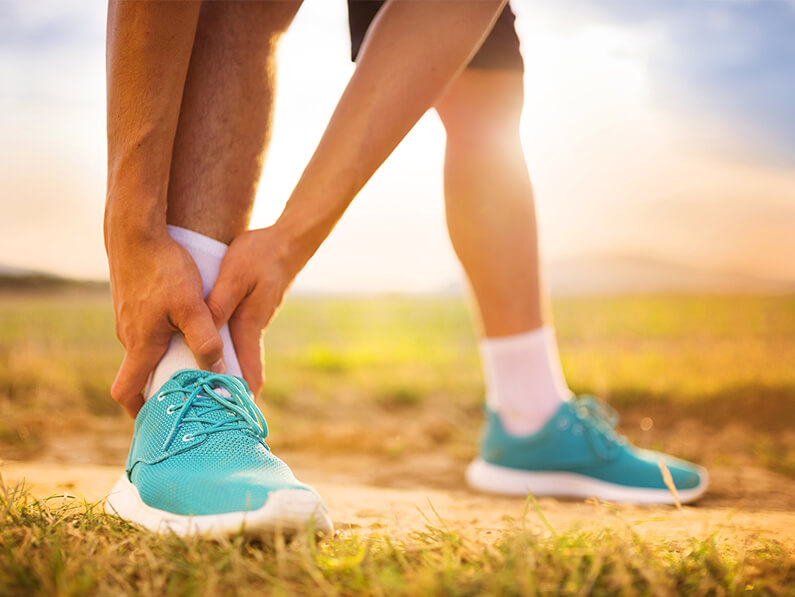
Foot and Ankle Pain is Never Normal
Your feet and legs are designed for normal walking and are critical to your daily life style helping us get from place to place. If you have experienced foot and ankle pain, you realize that your whole body suffers as you limp and try to accommodate to a normal lifestyle. Morning pain and stiffness, inability to wear shoes, pain with exercise, and with normal activity are typical of foot and ankle disorders. Our offices can provide you with diagnosis and treatment of foot and ankle disorders in a comprehensive manner to help improve your overall health and peace of mind. To help you understand your options, we’ve included descriptions of some of our leading services on this page.
Section Topics
Our Services:
- Bunion Syndrome
- Ingrown Toenails
- Plantar Fasciitis
- Heel Spurs
- Hammertoes
- Morton’s Neuroma
- Flat Foot Pain
- Foot and Leg Wounds and Ulcers
- Nerve Pain
- Foot and Ankle Fractures
- Fractures
- Charcot Foot
- Orthotic Management
- Achilles Tendon Injuries
- Ankle Pain and Instability
- Ankle Sprains
- Arthritic Foot & Ankle Care
- Warts
- Painful Corns and Callouses
- Hospital Management of Infection
- Trauma Management
- Foot Fungus Toenail Problems
- Geriatric Foot Care
- Diabetic Foot Preventative Foot Care
- Diabetic Shoes from Dr. Comfort
Ankle Sprains
Ankle sprains are usually caused by a fall or a slip where the ankle rolls over causing immediate pain, bruising, and swelling associated with an inability to continue walking or limping. The bruising and swelling is a direct result of torn ligaments and maybe associated with broken bones or fractures of the ankle and hind foot bones. This can happen in virtually any age group and is still the most common injury seen in emergency room or an urgent care facilities involving lower extremity injury. If you are unable to walk following an ankle injury or you feel that he may have felt a pop or a crack this may be a sign of a fracture and emergent medical evaluation is indicated. Initially, you should follow the RICE protocol of rest, ice, compression, and elevation. Most initial treatments are conservative in nature involving immobilization, edema reduction and pain management. However, most ankle sprains should heal with return to normal activity within 2 months. If your ankle injury goes untreated or fails to progress in a normal manner this may be an indication of a more serious ankle injury. Injuries caused by an unnatural twisting or force on the ankle bones of the foot, often resulting in one or more ligaments on the outside of the ankle to be stretched or torn. If not properly treated, ankle sprains could develop into long-term problems. If you suffer from chronic ankle pain or feel that you have unresolved acute ankle pain call the office for an appointment for a more appropriate evaluation so that you may return to a normal activity and lifestyle.
Bunion Syndrome
Bunion syndrome is a painful deformity associated with the big toe joint. A bump or swelling forms along the side of the great toe joint and can even grow on top of the toe joint. Bunions typically cause pain with walking and interferes with normal walking resulting in pain, redness and swelling around the big toe. Over time a Bunion can grow and develop malalignment with drifting of the great toe towards the second toe. Bunion syndrome can also occur with stiffness in the joint limiting normal range of motion. In some cases, the toes will overlap creating further instability with the development of hammertoes and other painful deformities. Sometimes, children can develop bunion deformity. Early treatment with orthotic management can help to delay the need for surgical correction. If corrective surgery is required, it is ideal to wait until the mid-teens to proceed once the foot bones have matured.
If you have painful bunions usually a complete history is performed with an emphasis on how the deformity is altering your lifestyle. Additionally, x-rays are usually taken on the first visit and discussion regarding both conservative and surgical options addressed. Conservative options include activity alteration, shoe modification, orthotic management, anti-inflammatory medication and even possibly cortisone injection. If conservative care fails to relieve the painful symptoms Dr. Michael Salcedo will review your x-ray and clinical findings and discuss a surgical plan to relieve you of your painful bunions. The surgical procedure is typically done on an outpatient basis in either one of the local hospitals or surgery centers under anesthesia. Antibiotics are used intravenously before surgery to help reduce the risk of infection. Most procedures with the allow an ambulatory status after surgery unless the deformity is severe. Postoperative pain management is prescribed and some patients may require physical therapy after surgery. The goal of bunion or hallux valgus management is to restore a normal lifestyle without foot pain or deformity.
Flat Feet
Flat feet can cause a variety of foot, leg, knee, hip, and lower back problems. Frequently, a flatfoot can be a normal finding. Many people live a completely normal life with feet that appear flat or have very high arches. However, when foot pain is associated with flat feet a thorough examination that includes a history and physical, x-ray evaluation, and musculoskeletal ultrasound can give important clues to includes to determine if the flatfoot is a source of your foot pain. The flatfoot conditions can cause a variety of tendon, bone, joint, and plantar fascia related problems that can cause debilitating pain, interfere with daily function or inferior sports performance. These problems can occur both as an infant, adolescent, and adult.
Flat feet in infants and toddlers generally requires proper history and examination of the lower back, hips, knees, legs and feet. A complete history and physical and includes a developmental history can give clues flatfoot deformity in children. The goals of therapy involve assisting the child in developing a more normal walk. This may include arch support, orthotics, shoe modification, bracing, and physical therapy. In some cases where conservative therapy fails surgical reconstruction to produce more normal-appearing arch tends to have excellent results in the child population with a flexible flatfoot. Rigid and spastic flat feet in adult and children tend to be a bit more difficult to treat. This is typically caused by a problem called coalition. Abnormal growth of bone and cartilage in between the joints creates pain and spasm with a flatfoot that is generally not reducible. Aggressive physical therapy and orthotics can sometimes help to relieve the pain and stiffness. When conservative care, orthotic management, and physical therapy fail to relieve the problem there are a variety of surgical remedies that can provide options to help relieve pain and restore normal function.
Flatfoot problems in adults develops with aging and is most associated with the development of arthritis and tendinitis. There is a natural progression of increase in foot size and arch drop with aging. However, the development of a flatfoot may be related to hip, knee, and lower back instability. Unfortunately, as we age arthritis is a normal progression and can progress without symptoms. Arthritis symptoms frequently present in the foot with arthritic bone spurs, heel pain, and pain normal walking related to falling arches. Typically, Dr. Michael Salcedo will perform a complete history and physical with an emphasis on understanding how your foot has changed over the years and how it affects your daily lifestyle. X-ray exam, CAT scan, or even a MRI can be used to fight the disease process. Your treatment would be individualized focused on a plan to improve your foot and leg function.
If you suffer from pain associated with a flatfoot you should be properly evaluated by a foot and ankle specialist. Early diagnosis and appropriate management can help improve long-term outcomes and improve your quality of life.
Hammertoes
A hammertoe is a contracture deformity of the toes that is caused by muscle and tendon imbalance. This problem can occur both with flat feet and high arch feet leading to pain on ambulation. The development of hammertoes can occur in a variety of age groups. It can also be associated with a variety of arthritic and neurologic problems that include osteoarthritis, rheumatoid disease, peripheral neuropathies and diabetes. As hammertoes developed the knuckles frequently rub on shoes or against the neighboring toe with associated corn formation. The result is pain and redness. In some cases this can lead to wounds.
Hammertoes generally affect the second, third, fourth, and fifth toes. The second and fifth toe seem to be the most commonly affected toes The great toe may also develop a hammer toe deformity. As hammertoes develop, the toes usually present as a flexible deformity. However, as the deformity develops with time, stiffness progresses within the toe and leads to further deformity causing pain across the bottom of the foot.
Surgery is generally not indicated when the deformity is cosmetic. Orthotics and wider shoes can help improve balance and foot function. However, once conservative care has been exhausted surgical remedies are generally very successful. Hammertoe repair is generally performed on an outpatient basis and can involve a variety of bone and soft tissue related procedures that can give long-lasting result with good functional results and cosmetic appearance.
Diabetes and Your Feet
Diabetes is complex disease that can have a significant effect on your overall health Diabetes is the #1 cause of non-traumatic amputations in the USA. The number of annual deaths from Diabetes from complications exceeds the combined annual death rate of Breast Cancer and AIDS combined. If you have diabetes; at a minimum, you should have your feet examined annually.
A typical office exam begins with begins with a history of your diabetes and any additional health problems you may have. Patients should see their primary care doctor and have hemoglobin A1c drawn every 3 months to document your blood sugar control levels. It is critically important to manage your blood sugar, blood pressure and weight. In patients who have controlled blood sugar; foot and ankle problems are generally minimal and are no greater risk than the normal healthy population. However, if you blood sugar is out of control there is an increased risk of circulation problems, nerve disease, and orthopedic problems that can lead to diabetic foot wounds.
A complete history and physical examination is performed. The assessment includes evaluation of arterial circulation with a Doppler exam, a neurological exam that includes gait assessment, muscle power evaluation and a sensory examination. Is important to document any deformity such as bunions, hammer toe, or arch collapse that lead to tissue injury, abnormal pressure, callus formation, and a formation of foot ulcers. Your examination may also include x-ray assessment of your feet, evaluation of shoe gear for abnormal wear and a determination of potential pressure points that may be prone to developing a foot wound.
With proper medical care, the majority of complications associated with diabetes are preventable. These measures include lifestyle changes and appropriate daily self-assessment of your feet. Your treatment plan may include debridement of callus and abnormal toenails with management using a diabetic shoe. Surgical management of foot and ankle deformity is generally directed at foot pressure relief for the management when conservative measures fail. Additionally, surgical management remains a corrective method for management of diabetic foot wounds with surgical debridement in a wound care center or in an In-Patient setting.
Reconstructive foot and ankle surgery is generally reserved for severely deformed feet or Charcot foot as a means of wound and infection prevention by restoring a more normal functional foot and ankle. Ultimately, the goal is to prevent foot ulcers, infection and amputation and improve quality of life.
Individuals diagnosed with diabetes need to have their feet inspected by a podiatrist at least once a year, and more frequently if they are experiencing trouble managing their diabetes. Many times, a podiatrist is the first to see signs of diabetes, and can make the appropriate referral for diagnosis and management. Diabetes will often affect a patient’s ability to heal from a seemingly insignificant injury, and in the foot this can have devastating consequences.
Treatment options include checking the feet top and bottom for ulcers, callus, deformity, and sensation or vascular changes. Ingrown or infected nails require professional care and self-treatment of many diabetic foot conditions should be considered hazardous. Shoes should be evaluated for proper fit, and prescription shoe gear with insoles can recommended where appropriate. Proper management of diabetes is crucial to avoiding the complications that are so often seen diabetic feet.
Heel Spurs
Plantar fasciitis (or heel pain) is commonly traced to an inflammation on the bottom of the foot. The most common cause of heel pain is associated with Plantar fasciitis. This is a common problem and is associated with morning pain, stiffness and difficulty in walking. Your exam will include a complete history and physical.
Diagnostics studies included foot, X-Ray and muscular skeletal ultrasounds. Muscular skeletal ultrasounds are the same technology used to evaluate babies in the pregnant mother. Ultrasound is used to examine injuries to tendons and the fasciitis heal pain can be very frustrating and requires export professional help.
Our practice can evaluate arch pain, and may prescribe customized shoe inserts called orthoses to help alleviate the pain. We also perform a variety of minimally invasive surgical procedures
Corns and Callouses
Corns and calluses are mostly caused by abnormal bone pressure on the shine caused by walking patterns. Your exam will consist of a history and physical exam and X-Ray to better understand the bone deformity associated with the corns or callouses. Treatment can range from simple trimming orthotic and gait training or surgery in resistant cases.
Athlete's Foot and Toenail Fungus
Dry itching sky with thickened discolored nails is a common sign of a fungal infections. Most people treat shoe fungus with over the counter creams. Usually the problem is either undertreated or not completed leading to recurrence or even resistance of the fungus to otc creams. Fungal infections may also progress to more serious skin infections requiring more urgent care. If you have repeated skin infections, you should be properly evaluated.
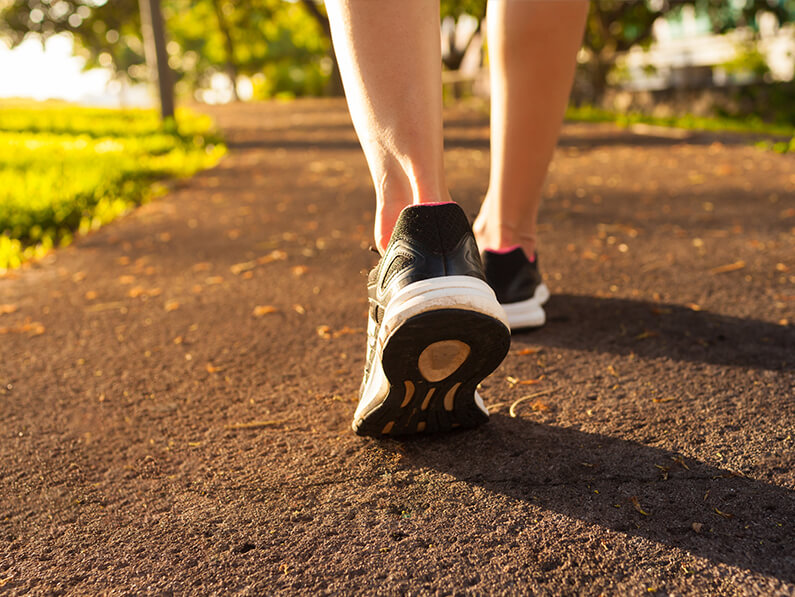
Overview of Foot and Ankle Problems
Foot and ankle problems usually fall into the following categories:
- Acquired from improper footwear, physical stress, or small mechanical changes within the foot.
- Arthritic foot problems, which typically involve one or more joints.
- Congenital foot problems, which occur at birth and are generally inherited.
- Infectious foot problems, which are caused by bacterial, viral, or fungal problems.
- Neoplastic disorders, also known as tumors, which are the result of abnormal growth of tissue anywhere on the foot and may be benign or malignant.
Traumatic foot problems, which are associated with foot and ankle injuries, such as fractures.
Leading foot problems are:
- Bunions—misaligned big toe joints that swell and become tender, causing the first joint of the big toe to slant outward and the second joint to angle toward the other toes. Bunions tend to be hereditary, but can be aggravated by shoes that are too narrow in the forefoot and toe. Surgery is frequently performed to correct the problem.
- Hammertoes—usually stemming from muscle imbalance, this condition occurs when the toe is bent into a claw-like position. Hammertoe can affect any toe, but most frequently occurs to the second toe, when a bunion slants the big toe toward and under it. Selecting shoes and socks that do not cramp the toes may help alleviate any aggravation of pain or discomfort.
- Heel Spurs—growths of bone on the underside, forepart of the heel bone. Heel spurs occur when the plantar tendon pulls at its attachment to the heel bone. This area of the heel later calcifies to form a spur. Proper warm-up and the use of appropriate athletic shoes can reduce the strain to the ligament and prevent the formation of heel spurs.
- Ingrown Toenails—toenails with corners or sides that dig painfully into the skin. Ingrown toenails are usually caused by improper nail trimming, but can also result from shoe pressure, injury, fungus infection, heredity, and poor foot structure. Women are more likely to have ingrown toenails than men. The problem can be prevented by trimming toenails straight across, selecting proper shoe styles and sizes, and responding to foot pain in a timely manner.
- Neuromas—enlarged benign growths of nerves, most commonly between the third and fourth toes. Neuromas are caused by tissue rubbing against and irritating the nerves. Pressure from ill-fitting shoes or abnormal bone structure can also lead to this condition. Depending on the severity, treatments may include orthotics (shoe inserts), cortisone injections, and, in extreme cases, surgical removal of the growth.
- Plantar Fasciitis—an inflammation on the bottom of the foot that leads to heel and/or arch pain. A variety of foot injuries or improper foot mechanics can lead to plantar fasciitis. Treatments range from icing and foot exercises to the prescription of custom orthotics to correct the foot position and help alleviate pain.
- Sesamoiditis—an inflammation or rupture of the two small bones (known as sesamoids) under the first metatarsal bone. Proper shoe selection and orthotics can help.
- Shin Splints—pain on either side of the leg bone caused by muscle or tendon inflammation. Shin splints are related to excessive foot pronation, but also may be related to a muscle imbalance between opposing muscle groups in the leg. Proper stretching before and after exercise and corrective orthotics for pronation can help prevent shin splints.
- Stress Fractures—incomplete cracks in bone caused by overuse. With complete rest, stress fractures in toes or any bones of the foot heal quickly. Extra padding in shoes can help prevent the condition. Left untreated, stress fractures may become complete bone fractures, which require casting and immobilization.
Sports Injuries
Many sports are hard on the feet because of quick repetitive movements, constricting footwear, and/or increased exposure to injury or trauma. Following is a brief overview of some of the most common injuries that result from particular sports.
Martial Arts and Kick Boxing
Injuries commonly seen as a result of martial arts and kick boxing include plantar fasciitis, Achilles tendonitis, sesamoiditis, and ankle sprains. Stretching is recommended to help prevent injury: specifically, a minimum of 15 minutes of stretching before performing any kicking or punching.
Aerobics
Impact forces from aerobics can reach up to six times the force of gravity, which is transmitted to each of the 26 bones in the foot. That is why proper shoes are crucial to successful, injury-free aerobics. Shoes should provide sufficient cushioning and shock absorption to compensate for pressure on the foot many times greater than found in walking. They must also have good medial-lateral stability.
Team Sports
Activities such as football, baseball, basketball, soccer, field hockey, and lacrosse often lead to ankle injuries as a result of play on artificial surfaces, improper footwear, and/or inadequate stretching.

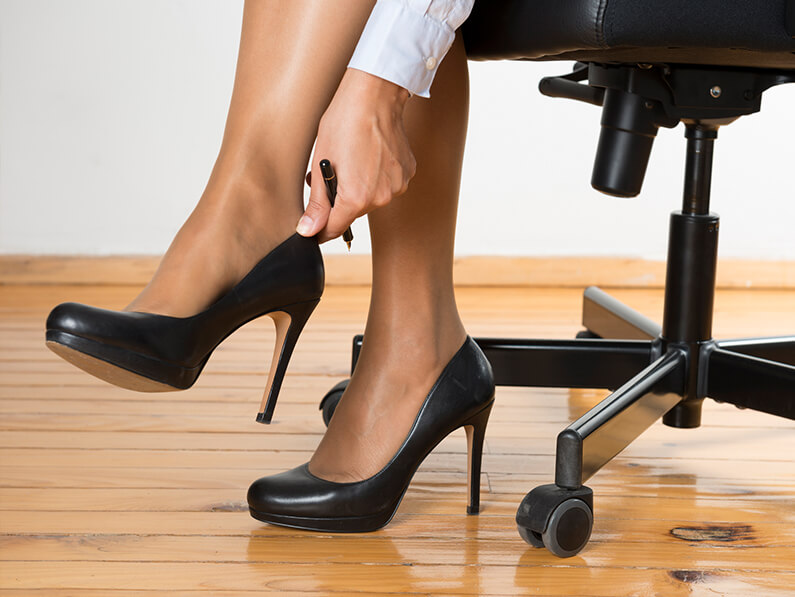
Your Feet at Work
Productive workers depend on their ability to walk and move about safely, with ease and comfort.
When your job requires you to stand on your feet for long periods, work in potentially hazardous areas or with potentially hazardous materials, you have some increased risk of foot injury. You can do a lot to prevent injuries by keeping your feet healthy and following safe work practices.
According to the National Safety Council, in any given year, there are about 120,000 job-related foot injuries, one-third of them toe injuries.
In addition to following the same basic foot care guidelines for all people, when you are on the job be sure to develop safe work habits and attitudes. This includes wearing protective footwear when appropriate. The National Safety Council also reports that only one out of four victims of job-related foot injury wear any type of safety shoe or boot. The remaining three either are unaware of the benefits of protective footwear or complain about it.
Orthotics
Orthotics, also known as orthoses, refers to any device inserted into a shoe, ranging from felt pads to custom-made shoe inserts that correct an abnormal or irregular, walking pattern. Sometimes called arch supports, orthotics allow people to stand, walk, and run more efficiently and comfortably. While over-the-counter orthotics are available and may help people with mild symptoms, they normally cannot correct the wide range of symptoms that prescription foot orthoses can since they are not custom made to fit an individual's unique foot structure.
Orthotic devices come in many shapes, sizes, and materials and fall into three main categories: those designed to change foot function, those that are primarily protective in nature, and those that combine functional control and protection.
Rigid Orthotics
Rigid orthotic devices are designed to control function and are used primarily for walking or dress shoes. They are often composed of a firm material, such as plastic or carbon fiber. Rigid orthotics are made from a mold after a podiatrist takes a plaster cast or other kind of image of the foot. Rigid orthotics control motion in the two major foot joints that lie directly below the ankle joint and may improve or eliminate strains, aches, and pains in the legs, thighs, and lower back.
Soft Orthotics
Soft orthotics are generally used to absorb shock, increase balance, and take pressure off uncomfortable or sore spots. They are usually effective for diabetic, arthritic, and deformed feet. Soft orthotics are typically made up of soft, cushioned materials so that they can be worn against the sole of the foot, extending from the heel past the ball of the foot, including the toes. Like rigid orthotics, soft orthotics are also made from a mold after a podiatrist takes a plaster cast or other kind of image of the foot.
Semi-Rigid Orthotics
Semi-rigid orthotics provide foot balance for walking or participating in sports. The typical semi-rigid orthotic is made up of layers of soft material, reinforced with more rigid materials. Semi-rigid orthotics are often prescribed for children to treat flatfoot and in-toeing or out-toeing disorders. These orthotics are also used to help athletes mitigate pain while they train and compete.
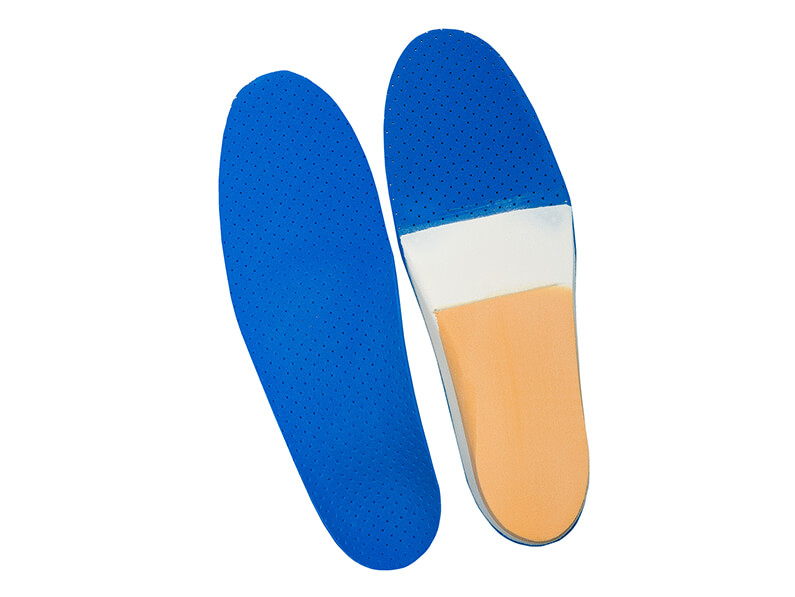
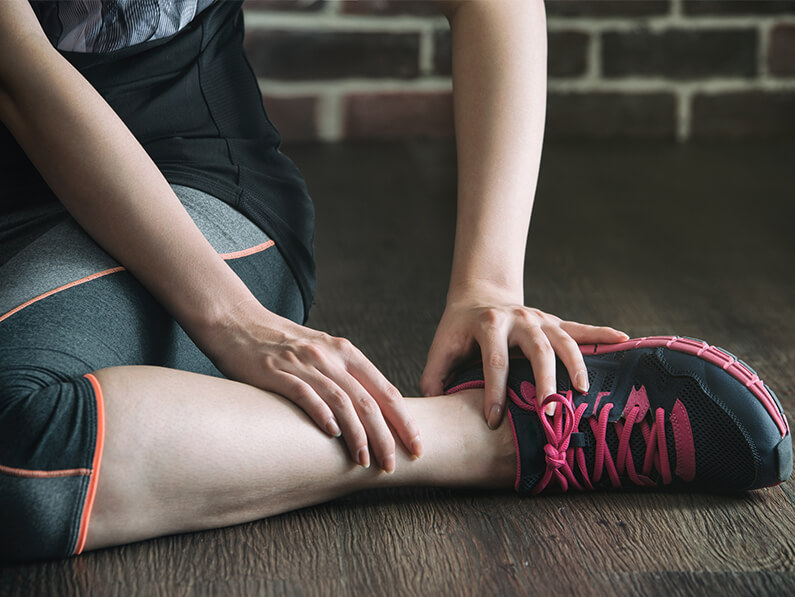
Ankle Sprain Injuries
Ankle sprains are caused by an unnatural twisting or force on the ankle bones of the foot, which may result in excessive stretching or tearing of one or more ligaments on the outside of the ankle. The severity of the sprain can impact the degree of damage as well as the type and duration of treatment. If not properly treated, ankle sprains may develop into long-term problems.
Primary symptoms of ankle sprains are pain following a twist or injury, swelling, and bruising.
Treatment includes resting and elevating the ankle and applying ice to reduce swelling. Compressive bandages also may be used to immobilize and support the injury during healing. Serious ankle sprains, particularly among competitive athletes, may require surgery to repair and tighten the damaged ligaments.
To prevent ankle sprains, try to maintain strength, balance, and flexibility in the foot and ankle through exercise and stretching, and wearing well-fitted shoes.
Bunions
A bunion is a bone deformity caused by an enlargement of the joint at the base and side of the big toe (metatarsophalangeal joint). Bunions form when the toe moves out of place. The enlargement and its protuberance cause friction and pressure as they rub against footwear. Over time, the movement of the big toe angles in toward the other toes, sometimes overlapping a third toe (known as Hallux Valgus). The growing enlargement or protuberance then causes more irritation or inflammation. In some cases, the big toe moves toward the second toe and rotates or twists, which is known as Hallus Abducto Valgus. Bunions can also lead to other toe deformities, such as hammertoe.
Many people with bunions suffer from discomfort and pain from the constant irritation, rubbing, and friction of the enlargement against shoes. The skin over the toe becomes red and tender. Because this joint flexes with every step, the bigger the bunion gets, the more it hurts to walk. Over time, bursitis or arthritis may set in, the skin on the bottom of the foot may become thicker, and everyday walking may become difficult—all contributing to chronic pain.
Wearing shoes that are too tight is the leading cause of bunions. Bunions are not hereditary, but they do tend to run in families, usually because of a faulty foot structure. Foot injuries, neuromuscular problems, flat feet, and pronated feet can contribute to their formation. It is estimated that bunions occur in 33 percent of the population in Western countries.
Treatment for Bunions
Because they are bone deformities, bunions do not resolve by themselves. The goal for bunion treatment is twofold: first, to relieve the pressure and pain caused by irritations, and second to stop any progressive growth of the enlargement. Commonly used methods for reducing pressure and pain caused by bunions include:
- Protective padding, often made from felt material, to eliminate the friction against shoes and help alleviate inflammation and skin problems.
- Removal of corns and calluses on the foot.
- Changing to carefully fitted footwear designed to accommodate the bunion and not contribute toward its growth.
- Orthotic devices—both over-the-counter and custom made—to help stabilize the joint and place the foot in the correct position for walking and standing.
- Exercises to maintain joint mobility and prevent stiffness or arthritis.
Splints for nighttime wear to help the toes and joint align properly. This is often recommended for adolescents with bunions, because their bone development may still be adaptable.
Surgical Treatment
Depending on the size of the enlargement, misalignment of the toe, and pain experienced, conservative treatments may not be adequate to prevent progressive damage from bunions. In these cases, bunion surgery, known as a bunionectomy, may be advised to remove the bunion and realign the toe.
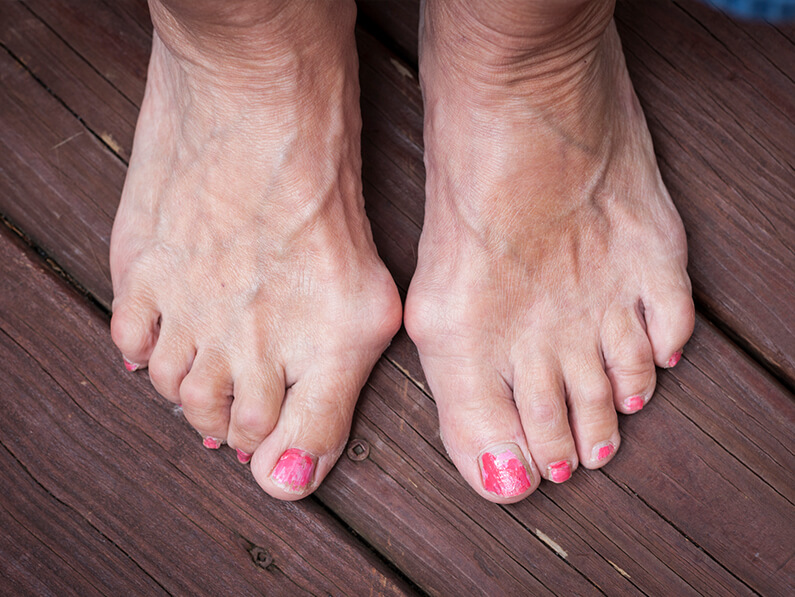
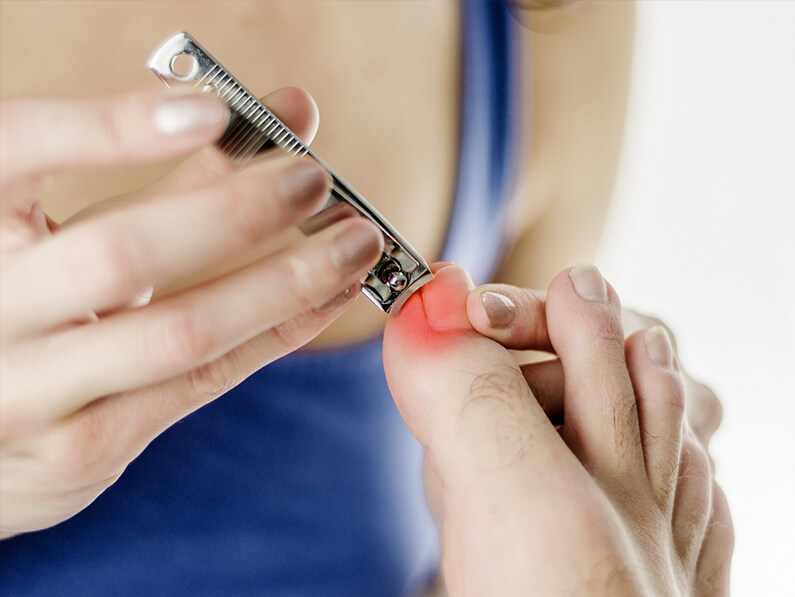
Ingrown Toenails
Ingrown toenails, also known as onychocryptosis, is usually caused by trimming toenails too short, particularly on the sides of the big toes. They may also be caused by shoe pressure (from shoes that are too tight or short), injury, fungus infection, heredity, or poor foot structure. Ingrown toenails occur when the corners or sides of the toenail dig into the skin, often causing infection. A common ailment, ingrown toenails can be painful. Ingrown toenails start out hard, swollen, and tender. Left untreated, they may become sore, red, and infected and the skin may start to grow over the ingrown toenail.
In most cases, treating ingrown toenails is simple: soak the foot in warm, soapy water several times each day. Avoid wearing tight shoes or socks. Antibiotics are sometimes prescribed if an infection is present.
Note: Please consult your physician before taking any medications. In severe cases, if an acute infection occurs, surgical removal of part of the ingrown toenail may be needed. Known as partial nail plate avulsion, the procedure involves injecting the toe with an anesthetic and cutting out the ingrown part of the toenail.
Ingrown toenails can be prevented by:
- Trimming toenails straight across with no rounded corners.
- Ensuring that shoes and socks are not too tight.
- Keeping feet clean at all times.
Michael Salcedo, D.P.M., F.A.C.F.A.S.
Address: 3665 Park Place West, Suite 200
Mishawaka, IN 46545
